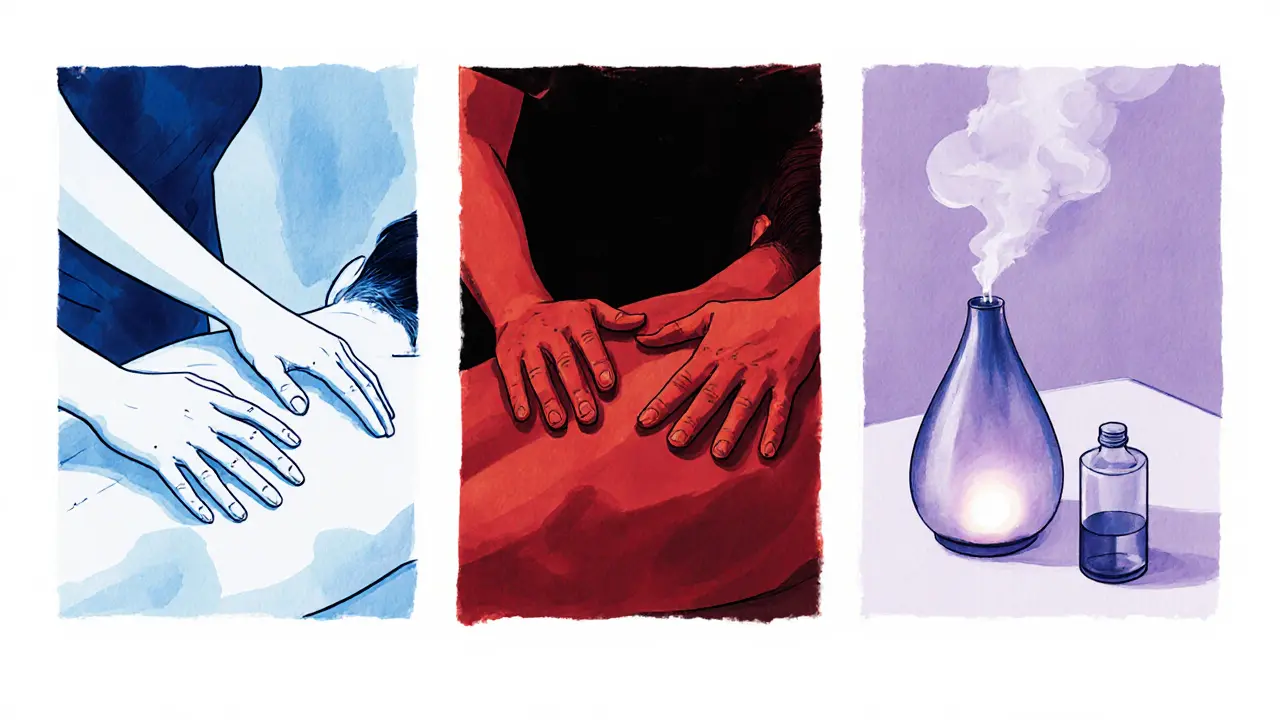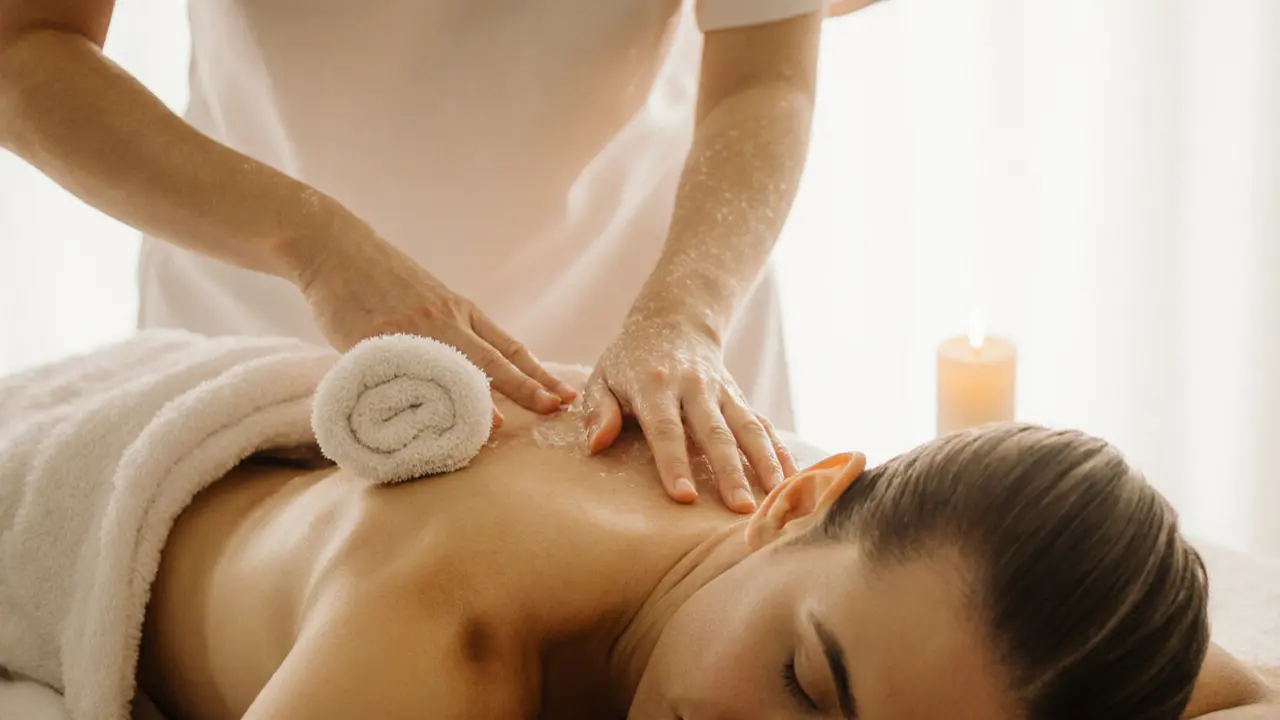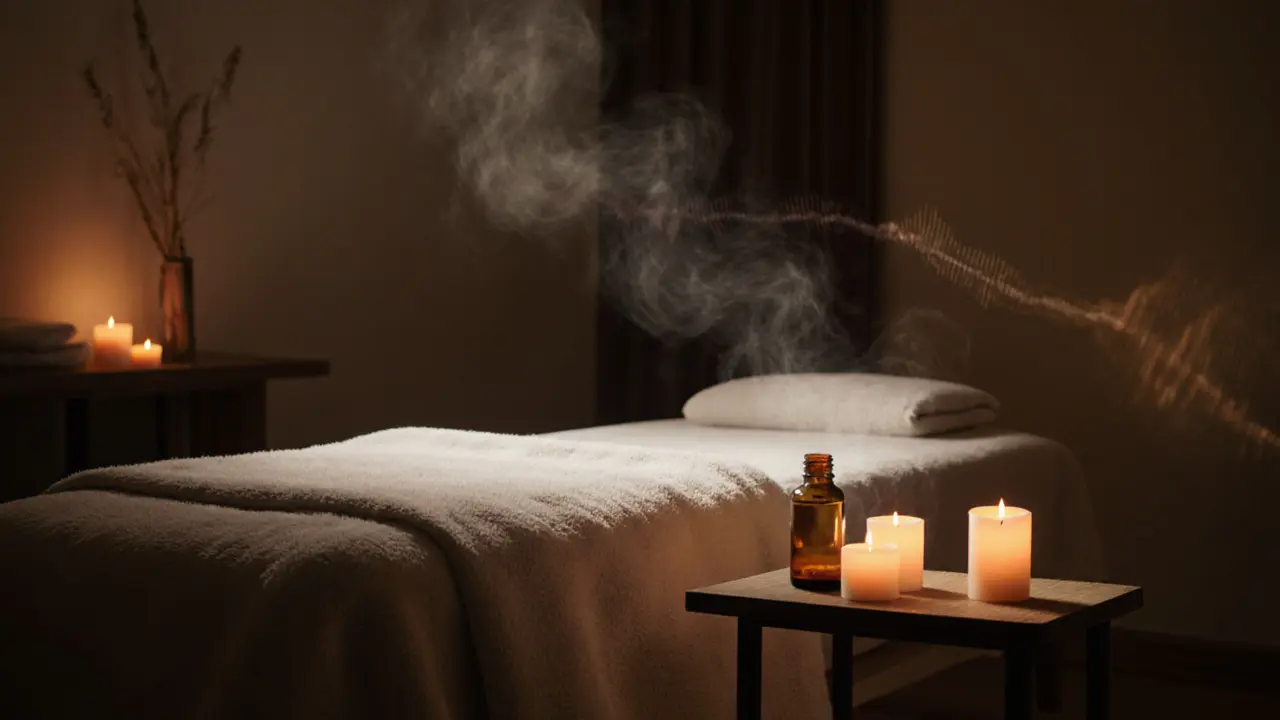When you want a body massage that stays in memory, it’s not just about strong hands - it’s a blend of setting, technique, and connection. Below you’ll find a step‑by‑step guide that turns an ordinary session into an unforgettable experience.
Set the Scene for Sensation
Before any oils touch skin, the room itself must whisper relaxation. Dim the lights, add a few Candles are unscented, low‑flame candles that create a soothing amber glow without overwhelming fragrance. A soft Music Playlist is a curated list of slow‑tempo instrumentals or ambient sounds that keep the pulse low and the mind calm. Keep the temperature around 72‑75°F (22‑24°C) and have a fresh towel within arm’s reach.
Pick the Right Technique
Different bodies respond to different strokes. Here are the three most popular approaches:
- Swedish Massage is a gentle, flow‑based method that uses long, gliding strokes to improve circulation and ease tension.
- Deep Tissue Massage is a firmer style that targets the deeper layers of muscle and connective tissue, ideal for chronic soreness.
- Aromatherapy Massage is a hybrid that combines light strokes with essential‑oil blends to stimulate the nervous system.
Choosing one depends on the client’s mood, physical condition, and how adventurous they feel.
Gather Your Tools
Quality tools turn good into great. You’ll need a sturdy Massage Table is a height‑adjustable platform with a padded surface that supports the body while allowing easy access for the therapist, a set of Hot Stones are smooth basalt rocks heated to 120‑130°F, used to relax muscles and deepen pressure (optional), and a bottle of Aromatherapy Oil is a carrier oil blended with essential oils such as lavender, eucalyptus, or ylang‑ylang for scent and skin benefits. If you want an extra layer of pampering, a light body scrub before the massage can remove dead skin and improve oil absorption.

The Flow: Step‑by‑Step Session
- Warm‑up: Start with gentle hand‑flats on the shoulders for 30 seconds to signal relaxation.
- Back Sweep: Use the forearms to glide from lower back up to the neck, following the spine’s natural curve. Repeat three times, adjusting pressure based on feedback.
- Focused Work: Switch to thumbs or elbows for any knots. Hold each spot for 8‑10 seconds, then release with a light stroke.
- Hot Stone Integration (if using): Place warmed stones on the shoulders and lower back for two minutes, then continue with regular strokes.
- Leg & Arm Release: Alternate between long strokes and kneading on the calves and forearms, mimicking the rhythm of a wave.
- Finishing Flourish: Light feather‑touches over the whole body for 45 seconds, then gently cover with a warm towel for a minute.
Throughout, ask simple questions like “Is this pressure okay?” or “Do you want more or less?” to keep the experience collaborative.
Pro Tips That Elevate the Experience
- Breath Sync: Encourage the receiver to inhale as you apply pressure and exhale as you release. This amplifies relaxation.
- Variable Pressure: Alternate between soft, flowing strokes and short, deep bursts to keep nerves guessing.
- Temperature Play: Dab a cool, damp towel on the forehead midway, then finish with a warm compress to heighten contrast.
- Hand Placement Awareness: Keep your elbows close to the body to avoid over‑stretching your own muscles.
- End with a Moment of Stillness: After the final stroke, stay silent for 30 seconds, letting the afterglow settle.

Common Mistakes to Dodge
Even seasoned practitioners slip up. Avoid these pitfalls:
- Rushing the warm‑up - the body needs time to transition into deep relaxation.
- Using too much oil - excess can make the skin slippery and reduce tactile feedback.
- Ignoring client feedback - what feels good to you may be painful for them.
- Neglecting posture - a slouched back transfers fatigue to you, shortening the session’s quality.
- Over‑relying on a single technique - mixing elements keeps the experience fresh.
Quick Comparison of Popular Techniques
| Aspect | Swedish | Deep Tissue | Aromatherapy |
|---|---|---|---|
| Primary Goal | Relaxation & circulation | Release chronic tension | Sensory enhancement |
| Pressure Level | Light‑to‑moderate | Moderate‑to‑strong | Light, combined with scent |
| Ideal For | First‑time clients, stress relief | Athletes, back‑pain sufferers | Clients who love fragrance, mood‑boosting |
| Typical Duration | 60‑90 min | 75‑120 min | 60‑90 min (includes oil blend) |
Frequently Asked Questions
How often should I get a body massage?
For general wellness, a monthly session keeps muscles supple. If you’re treating a specific issue, weekly visits may be recommended until symptoms improve.
Can I combine hot stones with aromatherapy?
Absolutely. Warm stones relax the muscles, making the skin more receptive to essential‑oil blends, which intensifies both physical and olfactory benefits.
What should I avoid eating before a massage?
Skip heavy, greasy meals at least two hours prior. Light proteins and hydration keep you comfortable and prevent post‑massage lethargy.
Is it safe to give myself a deep‑tissue massage?
Self‑massage works for mild tightness, but without a partner’s leverage you’ll miss the depth needed for chronic knots. Use a foam roller or massage ball for targeted pressure.
How do I choose the right aromatherapy oil?
Match scent to intent: lavender for calm, peppermint for invigoration, ylang‑ylang for sensuality. Always dilute with a carrier oil to avoid skin irritation.
By layering atmosphere, technique, and attentive feedback, you transform a routine body massage into a memory that lingers long after the towels are folded.







Wow, this guide really nails the vibe you need for a killer massage session. I love how it mixes chill lighting with practical steps – makes it super easy to follow and set the mood.
Indeed, the protocol delineates a systematic approach; however, one might consider integrating proprioceptive feedback loops, thereby enhancing neurovascular modulation, and ensuring a multimodal sensory cascade that optimizes the therapeutic output.
There is something truly magical about the way a thoughtfully arranged space can whisper calm into the very fibers of our being, and when you pair that with the gentle rhythm of a skilled therapist's hands, the experience elevates from a simple treatment to a lingering memory; the soft glow of candles, unscented to avoid overpowering the senses, creates a sanctuary where stress simply melts away; the curated playlist of slow‑tempo instrumentals acts like a gentle river, flowing around each breath, guiding the body into deeper relaxation; temperature plays a subtle yet crucial role, as the skin's receptors respond to the warm embrace of a room kept at just the right degrees; a fresh towel within arm’s reach not only adds a touch of professionalism but also signals preparedness and care; choosing between Swedish, deep tissue, or aromatherapy isn’t just a matter of preference, it’s a conversation with the body about what it needs at that moment; Swedish offers a graceful glide that opens circulation like sunrise over calm waters; deep tissue digs into the hidden knots, releasing tension with the persistence of a seasoned explorer; aromatherapy merges scent and touch, creating an olfactory canvas that paints calm across the mind; the tools-sturdy tables, hot stones, and quality oils-are the instruments that allow the therapist to compose this symphony of sensation; hot stones, warmed just right, act like warm breaths on weary muscles, coaxing them to let go; a light body scrub before the oil works like an invitation, clearing away the old to welcome the new; the step‑by‑step flow guides the session like a story, starting with a soft warm‑up to signal the mind to unwind, moving through back sweeps that follow the spine’s elegant curve, focusing on knots with thumbs and elbows as careful as a sculptor, integrating hot stones when appropriate, and ending with feather‑light flourishes that linger like a gentle sigh; breathing in sync with pressure creates a partnership where inhale fuels the push, and exhale releases the tension, a dance of air and touch; variable pressure keeps the nerves guessing, preventing habituation and deepening the impact; temperature play-cool damp towels followed by warm compresses-adds contrast that awakens the senses; mindful hand placement protects both client and therapist, ensuring the session remains sustainable; ending with a moment of stillness lets the afterglow settle, allowing the benefits to embed themselves fully; each of these elements, when woven together, transforms an ordinary massage into an unforgettable experience that stays with you long after the towels are folded.
While the guide is thorough, there is a minor grammatical slip: the phrase "A sturdy Massage Table is a height‑adjustable platform" should be phrased as "A sturdy massage table is a height‑adjustable platform"-the noun "massage" does not need capitalization here.
i cant believe how many peoploe fall for all this "massage" hype-its just a ploy by the elite wellness indusry to keep us hooked on their aromatics and stoney stuff, distract us from the real control they have over our minds, and the greeenlight they push is just technograpy et©.